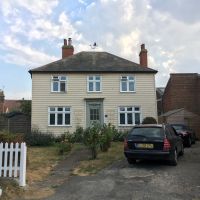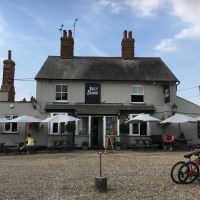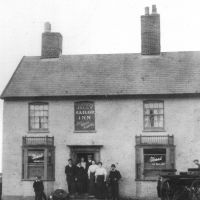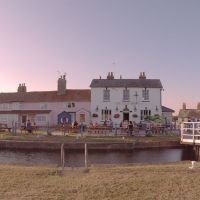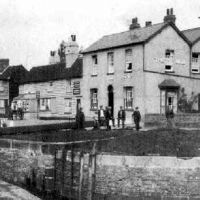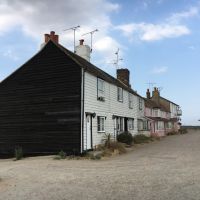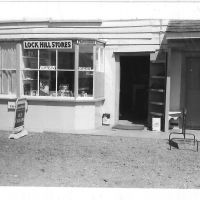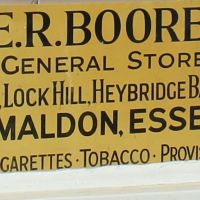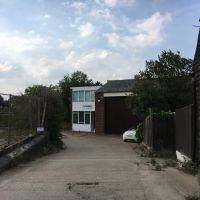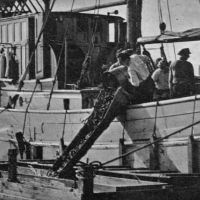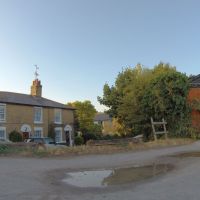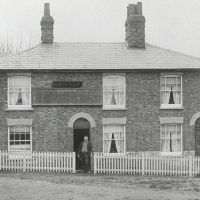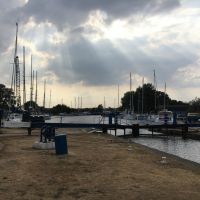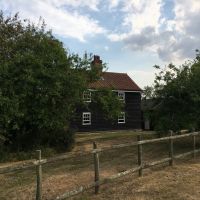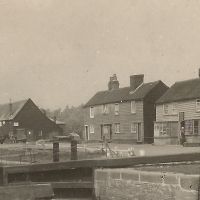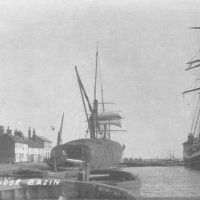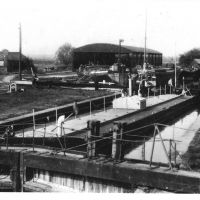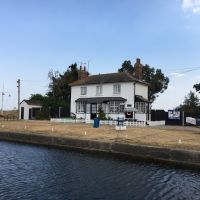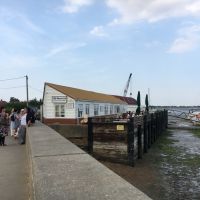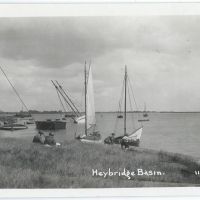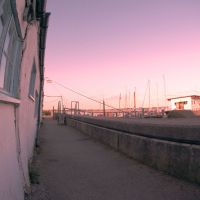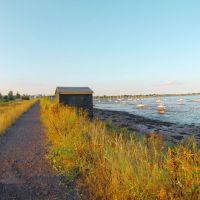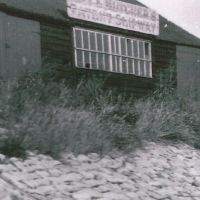Historic Walk
The Toll Gate
For 12 years in the early 1800s a gate blocked the entrance to the Basin Road and tolls were charged.
The gate had been erected by James Moffat Brook who lived at Saltcote Hall and claimed rights over the land. Tolls were collected by Mr Keys who leased the gate and cottage from James Brook.
In 1837 the owners of the Marine Salt Company objected to the tolls and their workmen sawed off the lock and opened the road to the public. Mr Brook took the Salt Company to court but lost his case.
The gate was never reinstated so feel free to carry on.
Charges:
- Foot passenger 1d
- Horse 2d
- Post chaise or carriage 2s
- One-horse chaise or gig 6d
- Donkey and cart 3d
- Beasts per score 1s
- Sheep and hogs 6d
Blackwater Sailing Club
On your left you will pass the private road leading to Blackwater Sailing Club. The Club House is built on the site which was occupied by the Marine Salt Company in the 19th century.
From here until you reach the junction with Blackwater Close you will be following the line of the old sea wall and all the land to your left was originally saltings or marsh, used for grazing.
Many maps show a tumulus on the marshland close to the Sailing Club gate. Opinions vary as to whether this was a burial mound, a red hill remaining from Roman salt extraction, or possibly a mound built for cattle grazing the marshes to retreat to in times of flood. During WW2 an air raid shelter dug into the mound served local farm workers, In later years village children played on the “high heap”. (Who smoked their first cigarette there?!)
The Bus Stop & St George’s Church
Head further along Basin Road to the bus shelter, popular meeting place for local teenagers since it was built in the late 1950s. Behind the bus shelter is St George’s Church. This building started out as the sergeants’ mess on Goldhanger Airfield during WW1. When the airfield was closed it was purchased by Mr Bentall, of the Heybridge agricultural engineering firm, . The building was moved to the Basin and opened as a “chapel of ease ” in March 1920.
The adjoining Community Room was opened in 2015 funded by grants and fantastic local fundraising. visit the church website for more information.
Spray Cottage
Pass the council houses, built in 1951 to address the shortage of houses after WW2, on your right and you come to Spray Cottage which was one of a number of shops operating in the village in the 1930s and 40s. Jesse Chaney sold sweets and tobacco here.
Next door but one during the 1970s and 80s Mrs Sheldrake ran the last village shop in the front room of Veronique.
On the opposite side of the road the houses in Maritime Avenue and Spinnaker Drive were built on the site of May & Butcher’s timber works when it closed in the 1980s.
The Old Butcher’s Shop
Continue along the road and on your left is the old butcher’s shop. Mr Wakeling from Goldhanger operated a butcher’s round by horse and cart and, in the 1930s, opened a shop in the Basin. When he died in 1940 his nephew Mr Leonard continued to run the shop and delivery round (by motor van now) until the 1970s.
The Barn House & Old Timber Yard
Two door further on is Barn House. Here Heybridge Basin Dairy was run by the Hume family who had moved to the Basin from Goldhanger soon after 1901. This continued until the 1930s.
Opposite these buildings is the entrance to the old timber yard. In 1946 Walter Burr started his business in the village, felling and bringing in English trees to be sawn, amongst other things, for pit props to be used in the mining industry. The business eventually closed in 1985.
Tinker’s Cottage
Continue past Barn House and on your left is Tinker’s Cottage. This is named after a previous resident, Charles “Tinker” Clark. He spent most of his working life on the navigation and Tinker was the name of his barge horse. He and his wife ran a shop selling tobacco and sweets in a lean-to beside his cottage.
Cross the road from Tinkers and you may catch a glimpse of the original cottage through the arched gateway next to this modern extension. Dora Batty (1891-1966) lived here from the 1930s until her death. She was an influential teacher at London design schools from the 1930s to the ’50s, head of the Textile Design Department at the Central School of Art. She is best known for a series of posters she did for the London Underground.
She named her cottage Starlings and this is one of her textile designs- also called Starlings.
The Flooded Cottages
This block of four terraced cottages were built around 1850, and featured in a postcard showing the flood of 1928. The photo features Rose Cottage, and shows food being handed up to a woman and her children in Rose Cottage, who had taken refuge upstairs.
Until the sea wall was built, properties in the village were frequently prone to flooding during high tides, thankfully no longer an issue in The Basin, but those of us who live in the older properties are used to the accumulated salt in our bricks showing up from time to time!
The Old Exchange
The Old Exchange, on the corner by Chapel Lane, was a public house during the 19th and into the early 20th century. On 23 March 1874, the tide was extremely high, causing the canal to overflow and flooding parts of the Basin to a depth of 2 or 3 feet. The then landlady, Emma Joslin, despite being assured her 3 children were safe with a neighbour and urged to retreat upstairs to safety. was found drowned at the foot of the stairs. The coroner said it was painfully clear that she must have fallen from the joint effects of drink and excitement, and the jury returned a verdict of accidental death.
The Old Chapel
Cross Chapel Lane and there is the sorry sight of the old chapel. Opened in 1834 it was used for worship until 2004.
The Reading Room, to the left of the main chapel, was used for local elections and meetings. Perhaps you attended Sunday School, or the Basin Play Group or Youth Club here.
When the chapel closed brass plaques commemorating the three men who died, and 60 men who served in the first world war were transferred to St George’s Church.
Iona Cottage & the Bombed cottages
On the bend by the chapel you will pass Iona Cottage on your left. A little way beyond is a terrace of 3 cottages.
Until 1943 2 longer terraces of cottages stood here.
On the morning of 11th January 1943 four bombs were dropped on the Basin. One of these landed on the two rows of cottages. Five villagers lost their lives that day and a sixth died in hospital 4 weeks later. All are remembered on the Heybridge War Memorial. Should we have something to remember them here in the Basin?
The Anchorage
Carry on towards the sea wall and on your right is the house now called The Anchorage.
An early plan of the Basin shows a house here, built for John Clark. He was appointed as Superintendant of the canal, keeping records of shipping and collecting dues, and raised his family in the Basin. His descendants continued to live in the Basin, working as wharf porters, mariners, watermen, fishermen and a Trinity Pilot. At least three of John’s 4x great grandchildren still live locally.
Later in the 19th century the house became the Live and Let Live public house.
The Jolly Sailor
Ahead of you the Jolly Sailor nestles beside the seawall. This was the first pub to be opened in the Basin, having been built in 1793 for the Writtle Brewery, and is the only one to have remained in continuous use.
Alfred “Tish” Clark, great grandson of John Clark, took over the licence in 1886 and was succeeded by his wife JaneWoodcraft (from another original Basin family) who it is claimed was the oldest licensee in England when she died in 1952. Their daughter Mona then ran the pub until 1968.
The Old Ship
Turn right by the Jolly and walk up onto Lock Hill. The two rows of weatherboarded cottages were some of the first dwellings to be built, appearing, along with a granary, on a 1799 plan of the Basin.
The Chelmer Brig public house opened in 1799, occupying.the end cottage of the row. In 1858 it was replaced by the present pub building which continued as the Chelmer Brig until 1894 when it became a private house. In 1906 it reopened as The Old Ship.
General Stores
This cottage on the Lock Hill was formerly a general stores providing both village residents and visiting sailors with provisions. As early as 1891 George Clark and his wife Emily were shown on the census keeping a shop on the Lock Hill. Emily continued as shop keeper for many years and was succeeded by her daughters Emily Rose Boorer and Mary Jane Moore. Mrs Boorer continued to keep the shop into the 1960s.
Eel business
At the foot of the hill beyond the cottages the premises now occupied by Hales Tool and Die Ltd were originally used by Mr Kuijten who in 1928 brought his live eel import business to the Basin. Eels were brought in by ship from Europe and North Africa until 1969. The business continued for three more years using large tanker lorries to carry the eels.
Beyond Hale’ premises there is a passage which leads back to Basin Road. The house on the right has replaced a row of cottages, originally the Carpenter’s Arms pub and occupying the site of the brewery which appears on an 1811 plan.
Workshops & Myrtle Cottage
Stay on the Lock Hill and walk past the derelict garage/workshops. These were built on the site of the granary which was built soon after the canal opened. It was eventually demolished in the 1950s.
On your right you will find a pair of cottages. Myrtle Cottage, on the left was the original Old Ship public house, the second pub to open in the Basin. It became a private house when the licence was transferred to the present Old Ship in 1906.
The Lock & Navigation Cottage
Turn back to the lock and cross the first lock gates. The canal basin nowadays is occupied by pleasure craft. In earlier times you could have seen timber lighters, eel boats, possibly stacky sailing barges or collier brigs.
Navigation Cottage was originally a pair of cottages, built by Richard and George Coates who had come to the Basin when the canal was being constructed and went into business importing timber and coal.
The Tea Rooms
Cross back over the lock gates and walk along the sea wall. Ahead, the Lock tea room has served as cafe and yacht stores over the years. Previously it was a private house, Pembury, one of the bungalows brought from HMS Osea in the 1920s.
Houses have existed on this odd spit of land since 1811. In 1852 when the ground was sold one of the buildings was described as a broken and decayd vessel which had been fitted up a dwelling house. Later”Aunt Diney” lived in an old cottage dubbed Rat Hall by the villagers. Pembury and Rat Hall are pictured on this 1930s postcard.
May & Butcher
Walk past the tea room along the sea wall, which was constructed in 1808 replacing an old rotten bank, and has been much built up and strengthened over the years.
The buildings you will find on your left, now used by Newham Council as part of their outdoor education centre, were the first premises of May & Butcher Ltd. Arthur Butcher, a shipwright, set up a workshop on the seawall. Joined by Mr May the company spread to the fields behind, constructing prefabricated wooden buildings. After WW1 the company bought and sold army surplus equipment, including tents and huts.
In 1920 May & Butcher began to bring in ships to be broken up. In WW2 wooden sections for aircraft were built and after the war minesweepers were brought in to be repaired or broken. The firm remained in business until the 1980s, manufacturing wooden shuttering used in bridge construction as well as their traditional gates and agricultural buildings.
Look over the seawall to your right and you will see the remains of their wharf, the concrete base for a derrick and, if the tide is low, the remains of the last minesweeper to be broken up.
Continue your walk past the playing field towards Millbeach, or perhaps turn back to find refreshment in the tea room, one of the two pubs or the kiosk on the canal side.




























